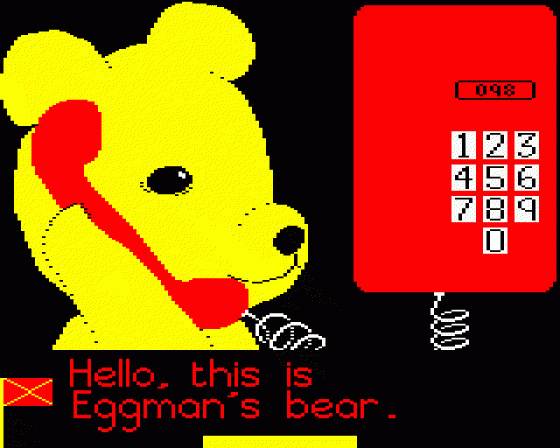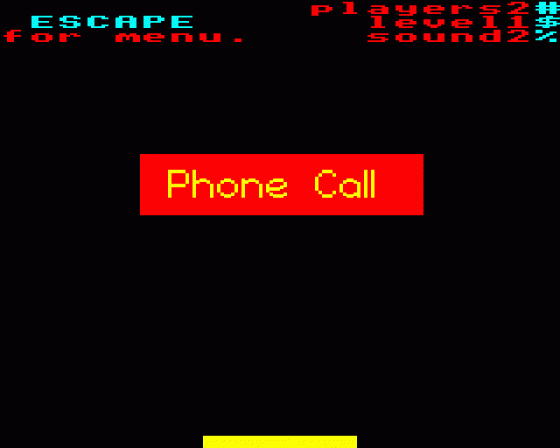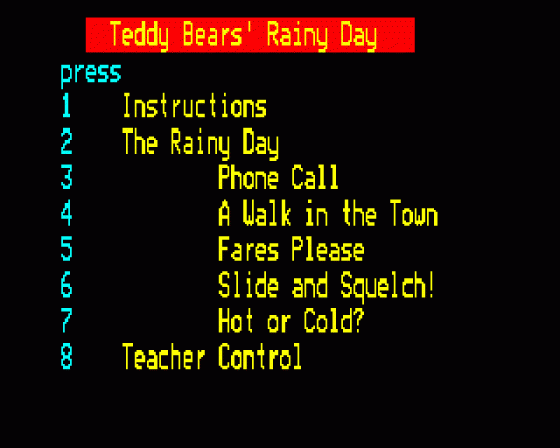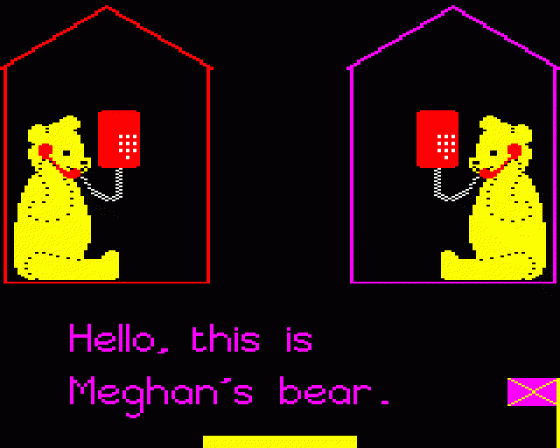
Beebug
 1st December 1993
1st December 1993
Categories: Review: Software
Author: Mark Sealey
Publisher: Sherston Software
Machine: BBC Model B
Published in Beebug Volume 12 Number 7
An unusual event: in this month's Beebug Education Mark Sealey looks at a new release for the 8-bit BBC micro.
Teddy Bear's Rainy Day (Sherston Software)
Good old Sherston! As the flow of new products for the BBC micro has all but dried up, one of the firms that has been on the scene since the beginning has brought out its last title for the BBC micro - and a good one, too.
Aimed at children in key stage 1 classes, Teddy Bear's Rainy Day is a topic-based package around the themes of bears, stories and the environment. Officially it is the sequel to the highly successful Teddy Bear's Picnic. But this farewell offering from Sherston can be used even if you are not familiar with the earlier product. At the start it should be said that everything you get if you decide to buy this pack (40 track DFS disc, teacher's and pupil's book, workcards and A3/A4 overlays) will delight you.
What Happens?
The package comes on two sides of the disc (a 3.5" ADFS version is available on request) and is booted in the usual way. An initial menu screen presents you with nine options. These are: read the instructions, teacher control, running side 2 and the five parts of the adventure.

Helpfully, the instruction screen takes the children through the various keys that are used in response to prompts throughout the program; these are subsequently used consistently in the software and make its use by even those most unused to the computer straightforward and easy.
Teacher Control allows you to adjust the way the program operates... the number of players (one or two, only), the level of difficulty (of which there are three), sound control (again three levels), and enabling/disabling the concept keyboard. It is also possible to make, edit and select sequences of up to eight lists of children's names; these can be subsequently selected on this page so that groups can be called to the computer to tackle specific exercises in a predetermined order without any immediate intervention from the teacher or adult.
It is also possible to control some of these options by key presses. Shift-3, for example, perhaps rather confusingly unless you can always remember it, toggles the player numbers. In all cases the options set are displayed where appropriate.

Other keys control what is happening in the five games themselves. Again, these are by and large logical: at bath time, for example, 'P' toggles the plug being put in or out.
By the time that you have reached the end of the main menu and started the adventure you will have discovered how much thought has gone into this program: for example, children are not required to press the Shift key when entering their names. It capitalises whatever initial letter is entered automatically. During conversations, colours and screen location indicate the participating 'speaker'.
The Adventures Themselves
There are five of these, which can either be tackled separately in any order or from the first (The Phone Call) to the last (Hot or Cold?).

The way that you actually approach these components will depend on how you intend to use the software as a whole. The fact that you have this choice is indicative of how far things have come in the design of this sort of pack. Flexibility of use has been emphasised at the expense of slick graphics and over-prescriptive and narrow "teaching points".
To decide on which parts of the adventure to use, how and in which order it is useful to read the introductory pages of the manual. In it, each adventure has a page to itself; what happens is briefly described, there is a graphic of what you can expect to see on screen, and details of the route through the scene. But, importantly, there is the author's assessment of the learning points that are covered.
It is useful to know, for instance, that in The Phone Call, numbers entered by the children that are not valid in the UK are not allowed, or that the combinations of coins possible in the bus ride section, Fares Please, vary according to level: they are restricted to pennies in level one but allow any grouping at level three. This is the sort of information that makes planning any use of the program so easy.

The material covered in the five adventures centres around: letters and numbers used in sequence (The Phone Call), geometry and safety awareness (A Walk in the Town), money and number facts (Fares Please), patterns and turtle geometry (Slide & Squelch), and opposites, temperature, timing and sequencing (Hot or Cold?).
There is a realistic progression through the events of the rainy day through which the teddy lives: he is invited out by Grandpa, travels to his house, gets mucky and has to clean himself up. It would thus be advisable for the children to experience the logic of this as a whole at least once before being expected to concentrate on particular aspects (geometry, number work or safety, for example) by use of the pre-set sequence facility that has been described earlier.
Documentation
As has been said more than once before now, the booklet that comes with Teddy's Rainy Day is excellent - in common with all Sherston's material.

The book is crammed with sight vocabulary (the words that the children can both learn from the package and which they will need to help them with it). There are umpteen suggestions for use and brief background information, for example, on the invention of the telephone and the classic ways of making one with cups and string. There is an exhaustive booklist and some guidance on difficulties which you may meet. The workcards and overlays are colourful and the pack comes in a plastic wallet - all in all an addition to the software library to be proud of!
Conclusion
This review has gone into detail in describing and evaluating Teddy Bear's Rainy Day. This is because the product epitomises the state of the art after eleven years of educational software for the BBC micro. It is easy to use, still original, albeit simple in idea and execution, well supported by the documentation and ancillary resources supplied as part of the pack, amenable of use in a variety of teaching styles and attractively presented.
Above all, Teddy Bear's Rainy Day actually can almost be guaranteed to sponsor real learning: the language that will be used whilst children are 'playing' with Teddy, the opportunities for problem solving, the promotion of logical thinking. There are mathematical skills to be exercised, especially in number work and turtle geometry. And, perhaps most importantly, the chance for an imaginative teacher to draw on the product to engage the almost inevitably enthusiastic children in both art and discussions on personal health and safety issues.
Even now, you could do a lot worse than buy Teddy Bear's Rainy Day; it is sensibly priced and could still - thanks to its emphasis on child safety and well being - fill a gap in the curriculum.











